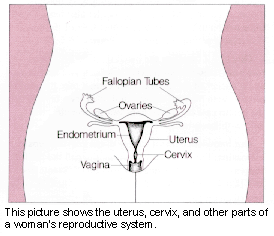In most instances, pre-cancerous or cancerous cells of the cervix are first detected with a Pap smear. All women should receive yearly Pap smears to help screen for cervical cancer beginning at age 18 or when they first become sexually active, whichever occurs earlier. Some physicians will not perform a Pap smear each year if a woman has had three negative Pap smears in the course of three years. However, a yearly pelvic exam should be continued even if Pap smears are not given each year.

If Pap smear results are abnormal, the patient’s physician may choose between a number of options based on the patient’s history and individual situation. These options include:
- Repeat Pap smear within four to six months.
- Colposcopy: The cervix is viewed through a colposcope (an instrument with a magnifying lenses) to check for abnormalities.
- Cervical biopsy: A portion of tissue from the cervix may be removed for further examination and to confirm if cancer is present.
- Cone biopsy: An elaborate cervical biopsy, a cone biopsy involves removing a cone-shaped region of tissue high on the cervical (that would not be seen with a colposcopy).
A cone biopsy may also be performed as a treatment if a cancer is small enough to be completely removed during biopsy. There are two main methods used to perform cone biopsy. The LEEP (also called LLETZ) method, short for loop electrosurgical excision procedure, removes the tissue by using a wire that is heated by an electrical current. Patients are given local anesthesia and the procedure can be performed quickly in a physician's office. Another method of cone biopsy involves using a surgical scalpel or laser to remove the tissue. This procedure typically requires general anesthesia and may be performed in a hospital or outpatient facility. However, an overnight hospital stay is usually not required.
The most common side effects of cone biopsy include cramping/discomfort and moderate or mild bleeding for a few weeks after the procedure. Patients should avoid sexual intercourse, tampons, and douching until the incision is completely healed, which may take several weeks. Patients should also discuss other possible side effects of cone biopsy prior to the procedure.
The advantages of cone biopsy are that it provides a large sample of tissue for analysis and it can sometimes completely remove the cancer so the patient does not need additional surgery. However, because complications from cone biopsy are possible, women should discuss all aspects of the procedure with their physician before undergoing biopsy. If a cone biopsy is recommended after abnormal Pap smear results, a patient may wish to ask if a colposcopy (looking at the cervix with magnification) or cervical biopsy would be an appropriate alternative for her (if they have not already been performed), based on her individual case.
If a biopsy has confirmed the presence of invasive cervical cancer, physicians may perform a number of tests to determine whether the cancer has spread (metastasized) past the cervix to other areas of the body. These tests may include:
- Cystoscopy: A small tube with a light on its tip is inserted through the urethra to examine the urethra and bladder. Physicians may perform a biopsy on this tissue to determine whether cancer cells are present.
- Proctoscopy: A small tube with a light on its tips is inserted through the rectum to check for cancer. A biopsy of this tissue may be performed to confirm that the cervical cancer has spread to the rectum.
- Pelvic examination: A thorough examination of the pelvis may be performed under general anesthesia to determine whether cancer has spread past the cervix.
- CT scan: Also called CAT scan (computed tomography), this exam combines the use of a digital computer together with a rotating x-ray device to create detailed cross sectional images of an organ or body part. CT is useful in determining whether cervical cancer has spread to the nearby lymph nodes.
- MRI scan: Also called MR scan (magnetic resonance), this exam uses magnetic energy and radio waves to create cross-sectional images of an organ or body part. MRI is useful in determining whether cervical cancer has spread to nearby organs or lymph nodes.
- Intravenous urography: Also called a intravenous pyelogram or IVP, this exam helps determine whether there are abnormalities in the urinary tract, which may be caused by the spread of cervical cancer cells to the pelvic lymph nodes.
Updated: June 9, 2008



